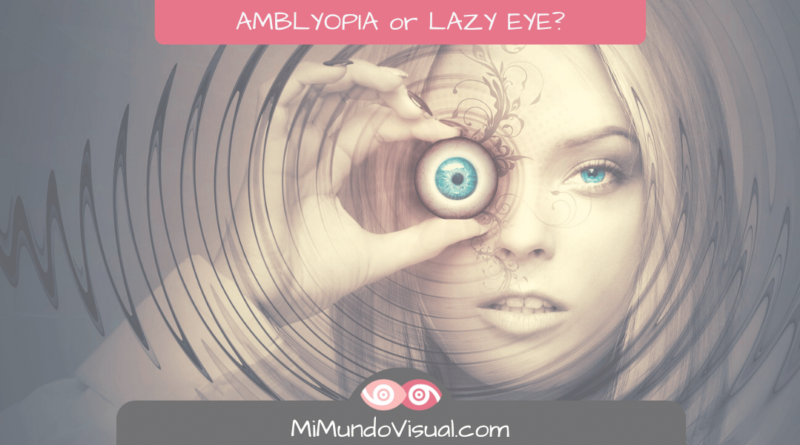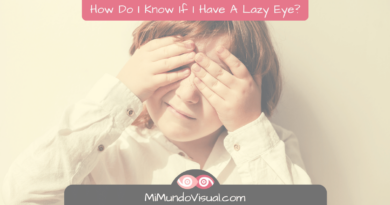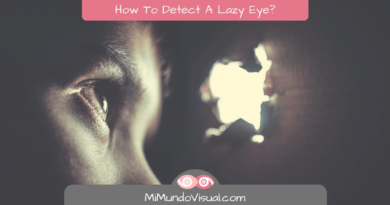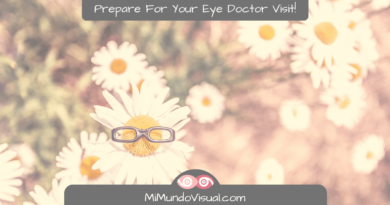What Is Amblyopia?
Table Of Contents
What is Amblyopia or 'lazy eye'?
What is Amblyopia or ‘lazy eye’? Its etymology indicates that it comes from the Greek amblyōpíā ἀμβλυωπία and means ‘weakness of sight,’ but what does it really mean to have a ‘Lazy Eye’?
In this article, we will cover the following topics:
- Introduction to Amblyopia,
- Understanding Amblyopia or Lazy Eye
- Observe the symptoms of Amblyopia
- Learn what causes Amblyopia,
- Uncover different types of treatments
- How to prevent Amblyopia
More About Amblyopia or Lazy Eye
- How Do I Know If I Have A Lazy Eye?
- What Causes Amblyopia Or Lazy Eye?
- How To Detect A Lazy Eye?
- What is Amblyopia?
- 6 Eye Patch Therapy Inconveniences We Are Not Told About
- How To Choose The Best Eye Patch For My Child?
- Contact Lenses For Children With Lazy Eye!
- 5 Questions About Lazy Eye In Adults!
- Lazy Eye In Adults – Little Everyday Difficulties That May Be Due To Amblyopia!

Amblyopia: What Is It Mean To Have A Lazy Eye?
- Amblyopia refers to a decrease in visual acuity.
- The visual acuity of the eye, called amblyopic or lazy eye, does not reach 100% vision,
- Even if the best optical correction is applied through glasses or lenses.
- A lazy eye is NOT the result of a disease.
- Nor is there any alteration in the structure of the eye.
An Amblyopic eye can develop at a younger age due to a lack of visual stimulation at a critical stage in a child’s visual development. While there is no injury to the eye itself, it still results in a loss or lack of development of visual acuity in one of the eyes.
Although Amblyopia usually affects only one eye, it can also occur in both eyes. In this case, neither eye can see at 100%.
For the visual system to develop correctly, it is necessary that both eyes can work together. So if someone suffers from a ‘Lazy Eye,’ the intent, at all costs, is to stimulate the amblyopic eye and teach it to work together with the other eye. However, it will first need to regain visual acuity to do that.
The amblyopic person has difficulties seeing clearly, focusing, moving the eyes correctly, and perceiving depth or 3D vision.
There cannot be any binocular competition for the visual system to work correctly. Since each eye should provide the brain with a very similar image, one with very few differences, this way, we can perceive our environment in depth.
The brain should receive clear and aligned images from both eyes. When one of the eyes suffers from Amblyopia, this process doesn’t happen. Instead, one of the eyes becomes dominant, and the brain starts to disregard the information the Amblyopic eye provides. This results in further loss of visual acuity for that eye.
When an Amblyopic eye, the image transmitted by one eye differs from the image generated by the other. The brain cannot merge these two different images. It prefers to suppress or block the poorer quality image as a defense mechanism. The lower-quality image generated by the amblyopic eye is losing relevance for the brain.
The brain has learned to ignore the image provided by the weaker eye and favors the stronger or dominant eye.
This way, the brain avoids confusion due to the blurred or misleading image sent by the lazy eye. Again this is mainly due to the insufficient development of the nerve pathway from this eye to the brain during childhood. However, other factors can also lead to Amblyopia.
What Are The Causes Of Amblyopia?
The lack of stimulation in one of the two eyes causes one eye to be used more than the other, and this can be due mainly to three causes:
Strabismus: each eye goes in a different direction. A deviation can be caused by muscular or congenital problems. Sometimes, the deviation is not observed aesthetically since its degree is minimal. Still, at a functional level, it is causing problems and is only observed when tests are performed by the eye doctor.
Anisometropia refers to a refractive problem where the graduation between the two eyes is very different. Therefore, one of the two eyes dominates, and the other is dominated since there is a very high difference in diopters between the two eyes. This results in each of the retinas providing very different images.
Cataracts: when one of the structures that allows light to reach the retina is not entirely transparent.

What are the symptoms of lazy eye?
Amblyopia may be accompanied by several symptoms, such as:
- Poor vision in one eye, which often causes a headache;
- It can also cause squinting, excessive blinking, or closing one eye to see better;
- Difficulty locating objects in space due to a deficiency in being able to detect depth; (Stereo Sue)
- Difficulties in balancing;
- And the most evident symptom, in some cases, is the deviation of one of the eyes inward or outward.
Although it is also true that in some cases, Amblyopia is only evident with an appropriate vision test since it can easily go unnoticed. Learn more on how to detect you can detect whether you have a Lazy Eye!
How can Amblyopia be treated?
Correcting the Amblyopia eye and treating it before 7-8 years of age is preferable since this is the stage of the highest brain plasticity.
We will get into the subject of amblyopia treatment in more depth later on due to the controversy that it entails on the part of the different professionals.
Still, we would like to comment briefly on the most commonly used treatments.
The most widespread and well-known way of treating the amblyopic eye is the occlusion of the dominant eye with the help of an eye patch.
Most ophthalmologists indicate that by covering the eye that sends the clear image to the brain, the weak or lazy eye ‘has to do all the work,’ leading to a gain in visual acuity.
Since the brain only has its reference to recognize the vision.
There are other methods, in case of non-acceptance of the eye patch, which hinders the vision of the dominant eye temporarily, such as:
- Dilation of the same with atropine.
- Bangerter’s penalizing filters on the spectacle lenses.
- Another alternative is visual therapy exercises to rehabilitate the amblyopic eye.
Visual Therapy for the Amblyopic eye utilizes a series of Visual Exercises to teach both eyes to work together.
As a recap: Due to Amblyopia, the brain has two very different images from each eye. What it does is try to unite these two images.
But when it has one image with a lower quality and another with a higher quality, it keeps the better one and discards the other.
So it is vital to work on the coordination of the two eyes to have good binocular vision.
Remember that there will be a need for optical correction. In other words, to have glasses or lenses with suitable graduation to start the treatment.
From the age of 6 months, it is possible to make a first assessment to evaluate the graduation and deviation.
That is why amblyopia treatment goes in two main phases:
- the first one is correcting visual acuity
- the second one is re-educating the connections between the eyes and the brain.
As mentioned, there are different opinions on how to approach Amblyopia and its treatment.
We encourage you to learn more about the different treatments that exist to combat Amblyopia or Lazy Eye. The truth is that there is no quick or easy fix to Amblyopia, and it requires a lot of effort and support to go through all the stages of the treatment.
Therefore, it is wise to discuss and consult with one or more vision professionals. As it is a long journey, it is of the utmost importance that we choose an eye doctor we fully trust so that they can guide us through the different stages of the treatment we have chosen.

How to Prevent Lazy Eye?
The most important thing is to have a routine ophthalmologic checkup in order to detect an Amblyopic or Lazy Eye as early as possible. As mentioned before, since it is a pathology that is generated during the first years of life, which is a critical period for a child’s vision to develop, it is necessary to treat it as soon as possible.
As we mentioned, in certain cases, it is easy to go unnoticed since it is a pathology that develops in the infantile stage.
The child has no reference to how it is to ‘see well,’ From the perspective of the child, their vision is normal.
Treatment can be a long and tedious path for a child suffering from an Amblyopic eye. It is important to recognize there is a high degree of commitment and compliance on the part of both parents and child required since the success of the treatment depends on it.
Conclusions About Amblyopia
To conclude, this article covered some of the basic principles of Amblyopia.
We covered what Amblyopia is, what its symptoms are, and its main causes and briefly discussed potential treatment for it.
But there is still much more to learn! At MiMundoVisual.com, we have created a lot more resources that go much deeper into certain areas of Amblyopia or Lazy Eye.
Here are a few pointers we’d like to highlight:
- Prevention is better than the ‘cure.’
- Choose a treatment that best suits your situation and your particular case.
- When a Lazy Eye is detected: The sooner we act, the more probability of success we will have.
- Motivation and the degree of commitment are also major players, and we must not forget them at any time.
Whether we are parents and our child has just been diagnosed with a lazy eye, or we suffer from it ourselves as adults, we hope this information has been useful. If you want to learn more but aren’t sure where to start. Don’t hesitate to download our free guide to Amblyopia. In that guide, we try to guide you to the relevant resources we have on the topic based on your needs.




